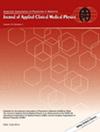Evaluating artifact-free four-dimensional computer tomography with 16 cm detector array
Abstract
Purpose
To evaluate a 16 cm-array axial four-dimensional computer tomography (4DCT) in comparison with a 4 cm-array 4DCT in the presence of respiration irregularity.
Method
Ten traces of lung tumor motion from CyberKnife treatments were imported to move the lung cylinder, containing a spherical target, of a phantom. Images were acquired for the lung that moved to each of the 10-positions/phases (1) step-wisely by nominal helical scan at each movement (ground truth), (2) continuously by 4D scan with the 16 cm array, and (3) the same with the 4 cm array, involving table shift. Irregularities, consisting of baseline shift and/or amplitude change of the traces in their second periods, affected #3 scan only in its second table position. The full-widths at half maximum of the target in the direction of the motion were determined on the average (Ave) CT, maximum-intensity (Mip) CT, and a phase (MP) CT that is associated with the maximum error, comparing #2 and 3 with #1. Three tumor-shaped targets were also imaged, and overlap ratios of them from #2 and 3 with the targets from #1 were inter-compared. Hounsfield unit (HU)s of the targets were also compared.
Results
The average difference in the spherical-target length between #2 and #1 was found to be 0.28 ± 0.15 cm on AveCT, 0.00 ± 0.18 cm on MipCT, and 0.07 ± 0.06 cm on MPCT, showing agreement. The average difference between #3 and #1 was 0.34 ± 0.23 cm on AveCT, 0.48 ± 0.31 cm on MipCT, and 0.56 ± 0.50 cm on MPCT, showing disagreement. The overlap ratios were better with #2 than with #3 for all tumor-shaped targets in each phase CT and MipCT, but they were not perfect for #2 due to motion averaging and phase sorting limitations. The differences in HUs were smaller with #2 than with #3, but not fully satisfactory with #2.
Conclusion
4DCT with the 16 cm array needs to be used to minimize the impact of the irregularity.


 求助内容:
求助内容: 应助结果提醒方式:
应助结果提醒方式:


